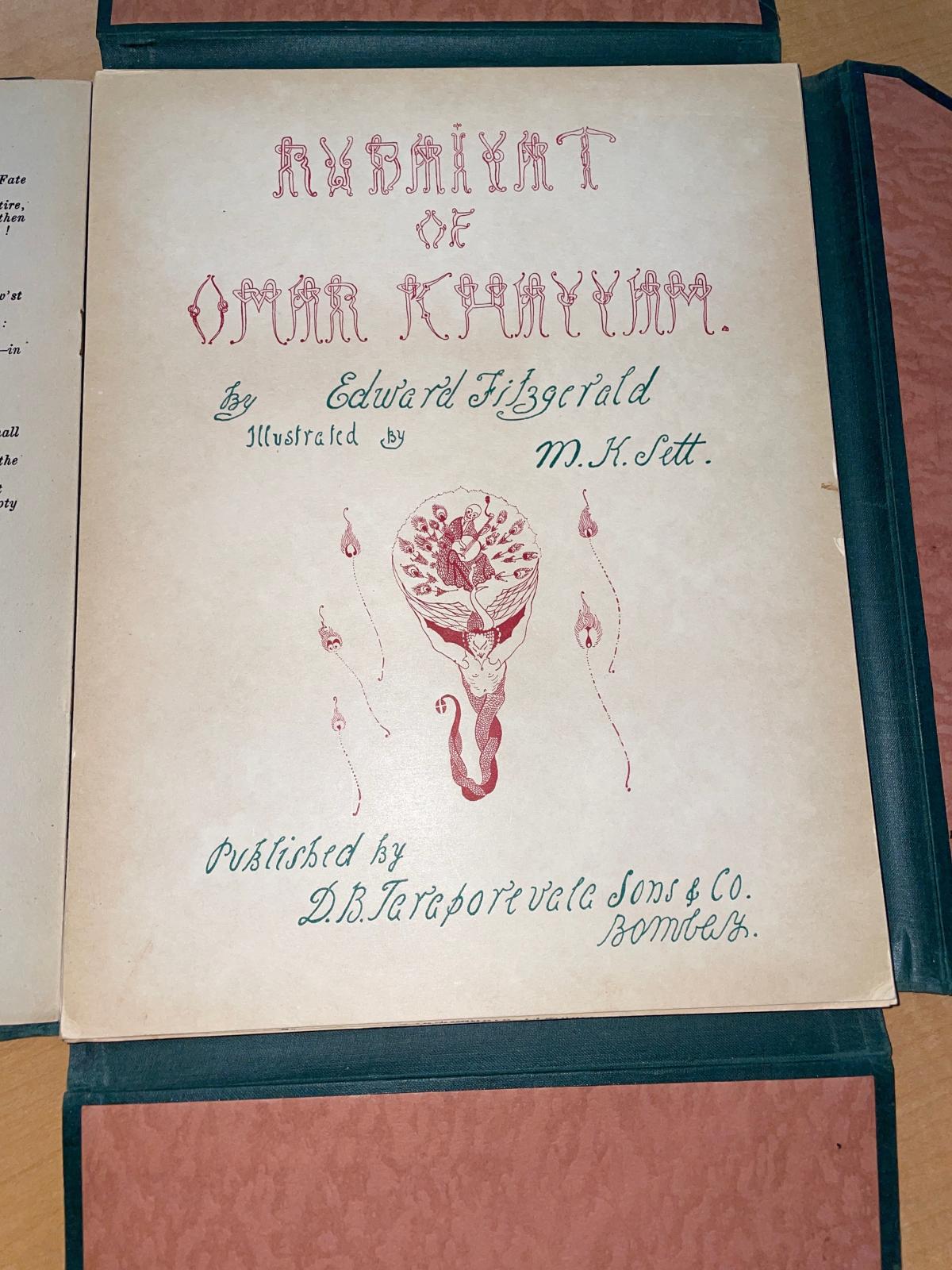Omar Khayyám, born in 1048, was a Persian poet who was also interested in mathematics, astronomy, philosophy. Although he wasn’t known in his lifetime for his poetry, it was after he passed that his poetry earned him lasting fame, particularly through the Rubáiyát of Omar Khayyám. This collection of quatrains, or rubáiyát, was introduced to the English-speaking world by Edward FitzGerald in 1859, whose translation brought Khayyám’s verses to life in a new cultural and literary context. FitzGerald’s interpretation of Khayyám's poetry emphasizes themes such as nature of life is fleeting, death is inevitable, and the importance of savoring the present. These messages often echo the idea of carpe diem (seizing the moment) as well as questioning religion and a desire to find deeper meaning in the human experience. These themes touched readers deeply and continue to fascinate readers today.
One unique edition of the Rubáiyát featured in this exhibit was published likely in 1946 by the Indian firm D.B. Taraporevala Sons & Co.. This version stands out not only for its rarity but also for the striking illustrations by Indian artist Mera Ben Kavas Sett. In the beginning of the book, Sett, who had gained recognition in Europe, wrote an introduction in standard print. In this introduction, Sett expresses how art is on the decline, and how ignorance and vulgarity are on the rise. His words reflect the challenges he faced in getting the book published: “When [Sett] attempted to find a publisher, he was informed his edition was ‘too shocking’ and ‘one likely to offend the sensitivity of respectable English individuals.’ They were ready to bring out my Omar if I changed a few pictures at their dictate and tastes, but I would not so much as a single line or dot” (Saffronart). After giving his thoughts on art, Sett explains why he drew his illustrations the way he did. He gave his "drawings a dash of the West" (4) and goes into detail explaining the symbolism and meaning behind each illustration. He then ends this introduction saying, "I have said my say, and with greetings and bendicitions on thee I take my leave" (5).
This edition is unbound, something that isn't super common these days, and has around 59 loose pages. The book has a four flap hard covered in a dark green and gilt cloth casing, measuring 9 x 11 1/2 inches. The letters on the cover have a unique font, so unique that I couldn't find the name of the font after searching for it. This leads me to believe that this was done by hand by Sett or the publishing house. The letters loop around similar to rope, but if you look closely enough, some of them have a humanesque look to them. The title on the cover appeared to have been sewn on in the gold gilt aforementioned.
Following Sett’s written introduction, the poem is also in standard print, accompanied by his hand-drawn illustrations. The first set of drawings are done in red ink, with the stanzas written in green ink encircling the images. These are followed by additional black-and-white illustrations, each paired with its corresponding quatrain printed on the verso. Sett even provides explanations for each illustration in his introduction, offering insight into his interpretive choices. What made this edition so “unusual” or “shocking” to British audiences at the time was its frequent use of nudity—depictions that challenged conventional ideas of propriety and made it difficult for Sett to find a willing publisher. Mera Ben Kavas Sett’s edition of the Rubáiyát not only reimagines Khayyám’s verses visually but also speaks to the cultural tensions surrounding art, censorship, and colonial-era morality. Through Sett’s bold illustrations and refusal to compromise his vision, this edition becomes a powerful testament to both artistic freedom and the timeless relevance of Khayyám’s poetic themes.
Sources:
“Monochrome -Feb 26-27, 2025 -Lot 59 -Salman Rushdie and Mera Ben Kavas Sett.” Saffronart, www.saffronart.com/auctions/PostWork.aspx?l=50633&eid=4895&lotno=59&n=59....


